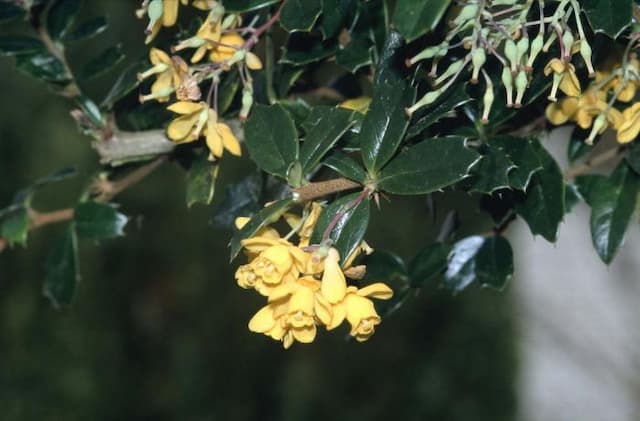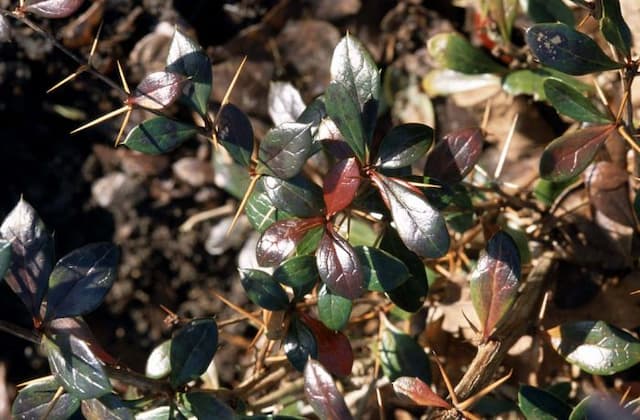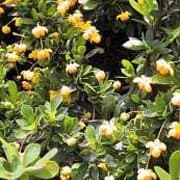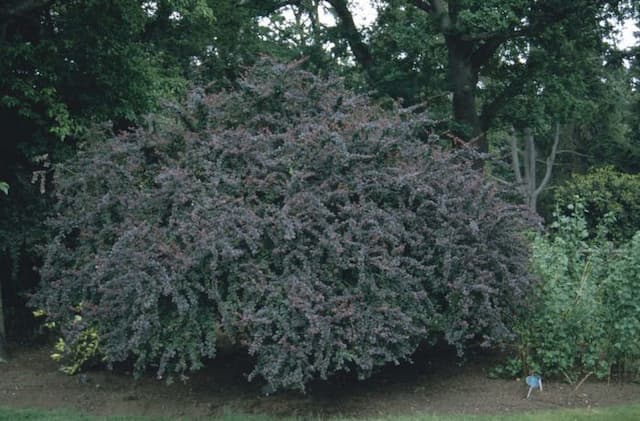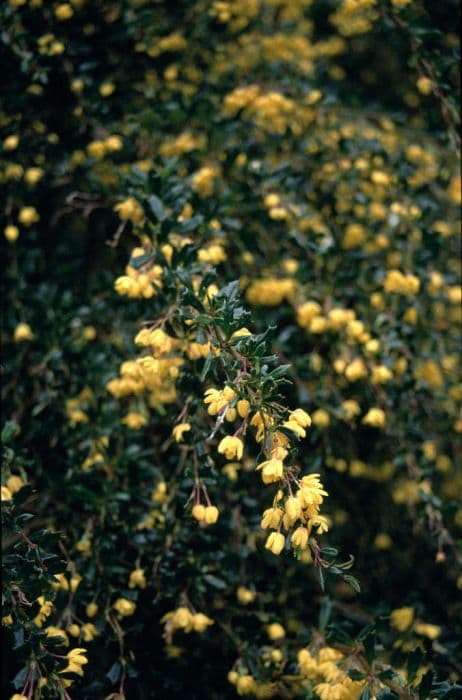Oregon grape Mahonia 'Arthur Menzies'
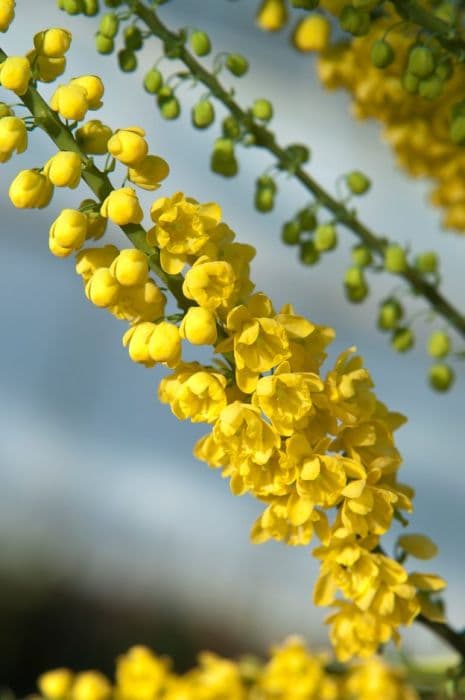
ABOUT
The Mahonia 'Arthur Menzies' showcases a striking appearance with its bold, evergreen foliage and distinct floral display. The leaves of this plant are reminiscent of holly, with a glossy, deep green color and spiny edges. Each leaf is comprised of multiple leaflets that are arranged in a pinnate fashion, providing a feathery look to the foliage. During the colder months, the leaves may acquire a purplish or reddish tinge, adding to the plant's visual appeal. In late winter to early spring, 'Arthur Menzies' produces dramatic, bright yellow flowers. These flowers are arranged in long, upright racemes that rise above the foliage, attracting attention with both their color and light, sweet fragrance. Following the flowering period, the plant often bears bluish-black berries, which are favored by birds and other wildlife. The overall impression of Mahonia 'Arthur Menzies' is one of a robust and architecturally appealing garden specimen, with year-round interest provided by its foliage, flowers, and berries. The plant's texture and color make it a standout addition to any garden space where it can be showcased for its ornamental qualities.
About this plant
 Names
NamesSynonyms
Arthur Menzies Mahonia, Oregon Grape, Grape Holly
Common names
Berberis 'Arthur Menzies'
 Toxicity
ToxicityTo humans
Oregon grape, including the cultivar 'Arthur Menzies', contains alkaloids such as berberine, which can be toxic if ingested in large quantities. Symptoms of Oregon grape poisoning may include nausea, vomiting, diarrhea, lethargy, and difficulty breathing. Ingesting large amounts can lead to potential kidney damage.
To pets
Oregon grape, including the cultivar 'Arthur Menzies', can be toxic to pets if ingested. The alkaloids present, particularly berberine, may lead to symptoms such as vomiting, diarrhea, weakness, and possible depression in pets. In severe cases, more significant symptoms could occur including potential kidney damage.
 Characteristics
CharacteristicsLife cycle
Perennials
Foliage type
Evergreen
Color of leaves
Green
Flower color
Yellow
Height
10 feet (3 meters)
Spread
5 feet (1.5 meters)
Plant type
Shrub
Hardiness zones
7
Native area
North America
Benefits
 General Benefits
General Benefits- Ornamental Appeal: Mahonia 'Arthur Menzies', commonly known as Oregon grape, has striking evergreen foliage and bright yellow flowers that add aesthetic value to gardens.
- Wildlife Habitat: Its berries provide food for birds and small mammals, while flowers can attract pollinators like bees and butterflies.
- Drought Tolerance: Once established, it is drought-resistant, making it suitable for xeriscaping and low-water gardens.
- Shade Tolerance: The plant can thrive in partial shade, allowing for versatile placement in various garden light conditions.
- Erosion Control: Oregon grape can be used on slopes and banks for stabilizing soil and preventing erosion.
- Winter Interest: Its evergreen leaves and sometimes persistent fruit offer visual interest in the winter landscape when other plants are dormant.
- Low Maintenance: Requires minimal care once established, making it ideal for gardeners seeking low-maintenance landscaping options.
- Privacy Screen: When planted in groups, it can serve as an effective visual screen or hedge for increased privacy.
 Medical Properties
Medical Properties- Antimicrobial: Mahonia 'Arthur Menzies' contains berberine, which has been shown to have antimicrobial properties against a variety of microorganisms.
- Anti-inflammatory: It has compounds that may reduce inflammation, potentially benefiting conditions with inflammatory components.
- Antioxidant: The presence of alkaloids like berberine also contributes to antioxidant effects.
 Air-purifying Qualities
Air-purifying QualitiesThis plant is not specifically known for air purifying qualities.
 Other Uses
Other Uses- Dye Production: The berries of the Oregon grape can be used to create natural plant dyes for textile coloring, imparting a yellow or blue-green hue.
- Photography: Extract from the berries can be used in alternative photography processes, such as anthotypes, where plant materials are used to create light-sensitive surfaces.
- Ink Making: Juice from the Oregon grape berries can be boiled down to concentrate their color and then mixed with a binder to create a natural ink for writing or drawing.
- Woodland Gardens: Oregon grape is an excellent plant for woodland garden settings, providing a natural understorey and supporting local biodiversity.
- Winter Interest: With its evergreen foliage and bright yellow flowers, the Oregon grape adds color and visual interest to gardens during the winter months when other plants are dormant.
- Landscape Design: Oregon grape's architectural foliage and growth habit can be used to create structure and form in landscape designs, acting as a focal point or a backdrop for other plants.
- Erosion Control: The sturdy, spreading root system of the Oregon grape makes it a practical choice for hillside plantings to help stabilize soil and prevent erosion.
- Wildlife Habitat: Oregon grape provides shelter and nesting opportunities for birds and small mammals in its dense foliage, making it a wildlife-friendly garden choice.
- Thematic Gardens: Suitable for native plant gardens or xeriscaping designs because it requires minimal water once established and supports local flora and fauna.
- Living Fences: With its prickly leaves, the Oregon grape can be grown as a barrier or hedge to deter trespassers and large animals.
Interesting Facts
 Feng Shui
Feng ShuiThe Oregon grape is not used in Feng Shui practice.
 Zodiac Sign Compitability
Zodiac Sign CompitabilityThe Oregon grape is not used in astrology practice.
 Plant Symbolism
Plant Symbolism- Tenacity: Mahonia 'Arthur Menzies', commonly known as Oregon Grape, often symbolizes tenacity because of its ability to thrive in various conditions and retain its foliage throughout the year.
- Protection: With its spiny leaves, Oregon Grape represents protection and defense. It is a plant that can form a barrier with its prickly texture, deterring animals and intruders.
- Healing: As Oregon Grape has medicinal properties, it is synonymous with healing. Traditional uses include treating infections and various health conditions.
 Water
WaterThe Oregon grape should be watered thoroughly, but infrequently, with a deep soak allowing the soil to dry out somewhat between waterings. Ensure you provide about 1 to 2 gallons per plant every week during the growing season, reducing this amount as the plant matures and natural rainfall increases. It's essential to avoid overwatering, as the plant does not like to sit in soggy soil. During the fall and winter, reduce the frequency of watering to match the decreased evaporation and plant needs.
 Light
LightThe Oregon grape thrives in partial shade to full sun. The ideal spot would provide some morning sunlight with shade in the harsh afternoon hours, especially in hotter climates. However, the plant is quite adaptable and can do well in moderately shaded areas, which can mimic its natural understory habitat.
 Temperature
TemperatureOregon grape prefers a moderate temperature range, typically thriving between 45 to 75 degrees Fahrenheit. It can withstand minimum temperatures down to 0 degrees Fahrenheit but may suffer damage if exposed to prolonged extreme cold below this range. It is relatively resilient to temperature fluctuations within its comfort zone.
 Pruning
PruningThe Oregon grape benefits from pruning to maintain its shape, remove dead or diseased wood, and promote vigorous growth. The best time to prune is late winter or early spring before new growth begins. Careful thinning of the plant once a year is typically sufficient to keep it healthy and well-shaped.
 Cleaning
CleaningAs needed
 Soil
SoilOregon grape 'Arthur Menzies' thrives best in a well-draining soil mix with a slightly acidic to neutral pH, preferably between 5.5 and 7.0. A mixture of garden soil, peat moss, and perlite or pumice is ideal to maintain appropriate moisture levels and ensure good root health.
 Repotting
RepottingOregon grape 'Arthur Menzies' does not require frequent repotting; it should be done every 3 to 4 years to refresh the soil. Overpotting can lead to excessive soil moisture and potential root issues.
 Humidity & Misting
Humidity & MistingOregon grape 'Arthur Menzies' prefers moderate humidity levels, but is quite adaptable and can tolerate the lower humidity typically found indoors.
 Suitable locations
Suitable locationsIndoor
Provide bright, indirect light and keep soil moist for Oregon grape.
Outdoor
Place in dappled sunlight or part shade, and water regularly.
Hardiness zone
5-9 USDA
 Life cycle
Life cycleThe life cycle of Mahonia 'Arthur Menzies', commonly known as Arthur Menzies Mahonia, begins with seed germination, typically in moist, well-drained soil in partial to full shade. Seedlings develop a root system and foliage, eventually forming a bushy evergreen shrub with pinnate leaves. As the plant matures, it produces clusters of bright yellow flowers in late winter to early spring, attracting pollinators such as bees. After pollination, these flowers develop into blue-black berries by late summer or fall, which are then dispersed by birds and animals, propagating new plants. The shrub continues to grow in size and will reach maturity in several years, forming a large and upright structure up to 10 feet tall. Throughout its life, the plant may undergo seasonal pruning to maintain shape and encourage healthy growth, while older specimens may experience reduced vigor and need rejuvenation pruning or replacement.
 Propogation
PropogationPropogation time
Autumn to Winter
Propogation: The Mahonia 'Arthur Menzies', commonly known as the Arthur Menzies Mahonia, is often propagated during the late winter or early spring before new growth begins. The most popular method for propagating this plant is through semi-hardwood cuttings. This involves taking a cutting of about 4 to 6 inches (10 to 15 cm) long from a healthy part of the plant, typically with several leaves. The lower leaves are removed and the cut end is dipped in rooting hormone to encourage root development. The cutting is then planted in a well-draining soil mixture, ensuring that at least a couple of nodes where leaves were removed are buried beneath the soil surface. The soil must be kept moist but not saturated, and the cutting should be placed in indirect light until it has rooted, which usually takes several weeks. Once roots have established, the new Arthur Menzies Mahonia can be transplanted to a more permanent location.
